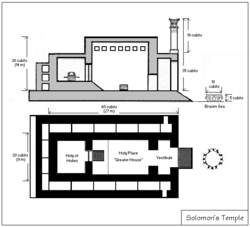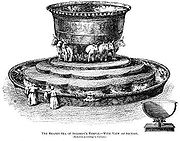
Kalwar
Encyclopedia
The Kalwar, Kalal or Kalar is a geographical title used by the Kalwar clan of Chandravanshi or Somvanshi Rajput
s and Thakur
s of Kalwar Thikana near Jaipur in Rajasthan referring to various geographical locations present globally viz. Kalal province in Pakistan, Qalal Azerbaijan, Kalar Iraq, Kalar Ardabil Iran, Qalat & Kalat in various countries (viz. Afghanistan, Algeria, Bahrain, Burma, Iran, Iraq, Saudi Arabia, Tunisia, Syria), Calvary ancient Jerusalem (Kalwari or Golgotha Hill where Christian God Jesus Christ was crucified) and anything related to it is named Kalwari, Kalwaria or Kalvarija Poland, etc. which is indicative of a dominating dynasty having strong influence spread over considerable geographical span before Invasions.

 In comparatively recent historical aspect Kalal refers people belonging to Kalal region in Pakistan who were also known as Pandas or Panedas meaning Brahmins indicating towards Rai or Brahmin Dynesty which ruled over those terrains before Islamic invasions and fallen back to positions in Indian Subcontinent after that. Few of them were forcefully converted and their descendents are still found there.
In comparatively recent historical aspect Kalal refers people belonging to Kalal region in Pakistan who were also known as Pandas or Panedas meaning Brahmins indicating towards Rai or Brahmin Dynesty which ruled over those terrains before Islamic invasions and fallen back to positions in Indian Subcontinent after that. Few of them were forcefully converted and their descendents are still found there.
Brahui Kur Galli, also known as Brahui of Kalat or Kalat(meaning cutters), a fierce tribe in South Afghanistan of Tajhik origin. They are distinguished from their Pushtun and Baluchi neighbors by language. The Pushtun and Baluchi speak Indo-Iranian languages, while the Brahui speak a Dravidian language. This is somewhat of a mystery to linguists because most Dravidian-speaking tribes live in southern India, more than 1000 miles away. They are believed to be descendents of their Warrior Brahmin anscestors.
Apart from Spain, Germany, Russia and other parts of Europe Kalals are also found in USA and they believe that word Kalal roots to Moravian Qalat meaning cutter, interestingly same as Afghani Qalat. Qalat also means Fortress a fortified place or fortified village or city.
Kalari(Foe Of Death) is Name of Hindu God Shiva's Mrutyunjay Aspect. Kalari also means battle field. Interestingly it also means preschool. Kalari refers to Kalantak or Mrutyunjay aspect of Hindu God Shiva and is more pertinent to the actual origin of Kalal which follows below. Kalantaka is also called as Kalakala (the Death of Death), Kalasamhara (slayer of Death), Kalari (Foe of Death) and Kalahara or Kalahari ("one who takes away death") and Markandeyanugraha ("bestowing grace upon Markandeya"). The suffix "murti" meaning image or icon may be added to these names e.g. Kalarimurti or Kalantakamurti. Shiva is also known as Mrityunjaya ("Victor over Death").
In Fact, Kalal or Qalal actually means Sacred Stone symbol referring to Deity(Shivlinga) placed at the centre of the Holiest of the Holy inside chamber (Garbhgruha) of the temples of Soloman. These temples has astonishing resemblance with temples of Hindu Lord Shiva and also with Sun temples built by Shakadvipis or Bhojak or Kambhojak Brhamins who are believed to have come from Asvaka or Land of Horses ancient continents of Kamboj and Saka. Kambhojaks are described as warriors and learned people(Brahmins) and were considered friends according to Vishnupurana. Temples of Soloman contained sacred stone referring to deity(Shivlinga) placed at the centre of the Holiest of the Holy inside chamber (Garbhgruha), outer chamber Holy Space(Mandapam), Brazen or Molten Sea(Kund) on Oxen(Nandi) in front, Prikrama Path, etc.
These temples were destroyed by Babylonian Invasions. Vessels including Kalal or sacred stone deity and Ark were hidden to protect them from invaders. Some people also relates Sacred Stone of Kaba to this which is out of scope here.
, Punjab and other parts of North and Central India. They are also found in Pakistan, Afghanistan, Russia, Middle East, Europe, USA etc.
, Jainism
and Sikhism
. Whereas, in other parts of world Kalwars or Kalals following Islam
and Christianity
are also found.
Kalwar Jagirdars or Zamindars performed Mehsuli or Revenue operations.
After fall of their estates some of them acquired Liquor profession. There are several schools of thoughts regarding this but most of them commonly believe that this was not traditional but circumstantial and comparatively recent. Some also believe that their acquaintance with Mewaras, Khandelwals and Chauhans of Rajasthan brought them into liquor business. Many of them are in iron ore and iron scrap processing, Hoteliers and trading business. Kalu(Teli) and Kulals or Kalwas of Khatik Samaj(belonging to Sudra classification) are also sometimes confused with Kalals but they are different Social Groups altogether. Usage of title 'Kalwar' or 'Kalal' as synonym for distillers and traders of alcohol is not appropriate. Some social groups of India traditionally engaged with alcohol distillation and trading are confused with Kalwars or Kalals which is also not appropriate.
Rajput
A Rajput is a member of one of the patrilineal clans of western, central, northern India and in some parts of Pakistan. Rajputs are descendants of one of the major ruling warrior classes in the Indian subcontinent, particularly North India...
s and Thakur
Thakur
Thakur may refer to:*Thakur *Thakur *Thakar , an Adivasi people in Maharashtra, India*Thakar - a Rajput caste of India.*Thakor is also another name of Hindu deities.-See also:*List of Gurjar clans...
s of Kalwar Thikana near Jaipur in Rajasthan referring to various geographical locations present globally viz. Kalal province in Pakistan, Qalal Azerbaijan, Kalar Iraq, Kalar Ardabil Iran, Qalat & Kalat in various countries (viz. Afghanistan, Algeria, Bahrain, Burma, Iran, Iraq, Saudi Arabia, Tunisia, Syria), Calvary ancient Jerusalem (Kalwari or Golgotha Hill where Christian God Jesus Christ was crucified) and anything related to it is named Kalwari, Kalwaria or Kalvarija Poland, etc. which is indicative of a dominating dynasty having strong influence spread over considerable geographical span before Invasions.
Origin History


Brahui Kur Galli, also known as Brahui of Kalat or Kalat(meaning cutters), a fierce tribe in South Afghanistan of Tajhik origin. They are distinguished from their Pushtun and Baluchi neighbors by language. The Pushtun and Baluchi speak Indo-Iranian languages, while the Brahui speak a Dravidian language. This is somewhat of a mystery to linguists because most Dravidian-speaking tribes live in southern India, more than 1000 miles away. They are believed to be descendents of their Warrior Brahmin anscestors.
Apart from Spain, Germany, Russia and other parts of Europe Kalals are also found in USA and they believe that word Kalal roots to Moravian Qalat meaning cutter, interestingly same as Afghani Qalat. Qalat also means Fortress a fortified place or fortified village or city.
Kalari(Foe Of Death) is Name of Hindu God Shiva's Mrutyunjay Aspect. Kalari also means battle field. Interestingly it also means preschool. Kalari refers to Kalantak or Mrutyunjay aspect of Hindu God Shiva and is more pertinent to the actual origin of Kalal which follows below. Kalantaka is also called as Kalakala (the Death of Death), Kalasamhara (slayer of Death), Kalari (Foe of Death) and Kalahara or Kalahari ("one who takes away death") and Markandeyanugraha ("bestowing grace upon Markandeya"). The suffix "murti" meaning image or icon may be added to these names e.g. Kalarimurti or Kalantakamurti. Shiva is also known as Mrityunjaya ("Victor over Death").
In Fact, Kalal or Qalal actually means Sacred Stone symbol referring to Deity(Shivlinga) placed at the centre of the Holiest of the Holy inside chamber (Garbhgruha) of the temples of Soloman. These temples has astonishing resemblance with temples of Hindu Lord Shiva and also with Sun temples built by Shakadvipis or Bhojak or Kambhojak Brhamins who are believed to have come from Asvaka or Land of Horses ancient continents of Kamboj and Saka. Kambhojaks are described as warriors and learned people(Brahmins) and were considered friends according to Vishnupurana. Temples of Soloman contained sacred stone referring to deity(Shivlinga) placed at the centre of the Holiest of the Holy inside chamber (Garbhgruha), outer chamber Holy Space(Mandapam), Brazen or Molten Sea(Kund) on Oxen(Nandi) in front, Prikrama Path, etc.
These temples were destroyed by Babylonian Invasions. Vessels including Kalal or sacred stone deity and Ark were hidden to protect them from invaders. Some people also relates Sacred Stone of Kaba to this which is out of scope here.
Distribution
Kalwars or Kalals are found in RajasthanRajasthan
Rājasthān the land of Rajasthanis, , is the largest state of the Republic of India by area. It is located in the northwest of India. It encompasses most of the area of the large, inhospitable Great Indian Desert , which has an edge paralleling the Sutlej-Indus river valley along its border with...
, Punjab and other parts of North and Central India. They are also found in Pakistan, Afghanistan, Russia, Middle East, Europe, USA etc.
Religion
Kalwars in India Mainly follow HinduismHinduism
Hinduism is the predominant and indigenous religious tradition of the Indian Subcontinent. Hinduism is known to its followers as , amongst many other expressions...
, Jainism
Jainism
Jainism is an Indian religion that prescribes a path of non-violence towards all living beings. Its philosophy and practice emphasize the necessity of self-effort to move the soul towards divine consciousness and liberation. Any soul that has conquered its own inner enemies and achieved the state...
and Sikhism
Sikhism
Sikhism is a monotheistic religion founded during the 15th century in the Punjab region, by Guru Nanak Dev and continued to progress with ten successive Sikh Gurus . It is the fifth-largest organized religion in the world and one of the fastest-growing...
. Whereas, in other parts of world Kalwars or Kalals following Islam
Islam
Islam . The most common are and . : Arabic pronunciation varies regionally. The first vowel ranges from ~~. The second vowel ranges from ~~~...
and Christianity
Christianity
Christianity is a monotheistic religion based on the life and teachings of Jesus as presented in canonical gospels and other New Testament writings...
are also found.
General
Kalwars Portraits as Efficient Rulers and Gallant Warriors in Ancient, Medieval and Recent History of Indian Subcontinent.Kalwar Jagirdars or Zamindars performed Mehsuli or Revenue operations.
After fall of their estates some of them acquired Liquor profession. There are several schools of thoughts regarding this but most of them commonly believe that this was not traditional but circumstantial and comparatively recent. Some also believe that their acquaintance with Mewaras, Khandelwals and Chauhans of Rajasthan brought them into liquor business. Many of them are in iron ore and iron scrap processing, Hoteliers and trading business. Kalu(Teli) and Kulals or Kalwas of Khatik Samaj(belonging to Sudra classification) are also sometimes confused with Kalals but they are different Social Groups altogether. Usage of title 'Kalwar' or 'Kalal' as synonym for distillers and traders of alcohol is not appropriate. Some social groups of India traditionally engaged with alcohol distillation and trading are confused with Kalwars or Kalals which is also not appropriate.

